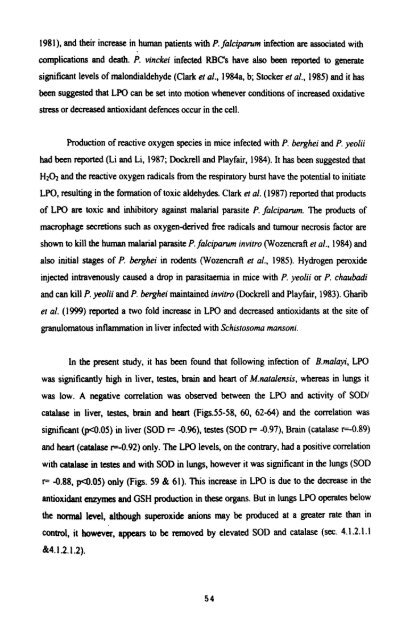effect of infection of the filarial parasite brugia malayi - Pondicherry ...
effect of infection of the filarial parasite brugia malayi - Pondicherry ...
effect of infection of the filarial parasite brugia malayi - Pondicherry ...
You also want an ePaper? Increase the reach of your titles
YUMPU automatically turns print PDFs into web optimized ePapers that Google loves.
1981), and <strong>the</strong>ir increase in human patients with P.falciparum <strong>infection</strong> are associated with<br />
complications and death. P. vinckei infected RBCs have also been reported to generate<br />
significant levels <strong>of</strong> malondialdehyde (Clark et al., 1984a, b; Stocker et al., 1985) and it has<br />
been suggested that LPO can be set into motion whenever conditions <strong>of</strong> increased oxidative<br />
stress or decreased antioxidant defences occur in <strong>the</strong> cell.<br />
Production <strong>of</strong> reactive oxygen species in mice infected with P. berghei and P. yeolii<br />
had been reported (Li and Li, 1987; Dockrell and Playfair, 1984). It has been suggested that<br />
HI@ and <strong>the</strong> reactive oxygen radicals from <strong>the</strong> respiratory burst have <strong>the</strong> potential to initiate<br />
LPO, resulting in <strong>the</strong> formation <strong>of</strong> toxic aldehydes. Clark ei al. (1987) reported that products<br />
<strong>of</strong> LPO are toxic and inhibitory against malarial <strong>parasite</strong> P. falcipam. The products <strong>of</strong><br />
macrophage secretions such as oxygenderived free radicals and tumour necrosis factor are<br />
shown to kill <strong>the</strong> human malarial <strong>parasite</strong> P. falciparum invitro (Worncraft er al., 1984) and<br />
also initial stages <strong>of</strong> P. berghei in rodents (Wozencrafl et al., 1985). Hydrogen peroxide<br />
injected intravenously caused a drop in parasitaemia in mice with P. yeolii or P. chaubadi<br />
and can kill P. yeolii and P, berghei maintained invifro (Dockrell and Playfair, 1983). Gharib<br />
et al. (1999) reported a two fold increase in LPO and decreased antioxidants at <strong>the</strong> site <strong>of</strong><br />
pulomatous inflammation in liver infected with Schistosoma mansoni.<br />
ln <strong>the</strong> present study, it has been found that following <strong>infection</strong> <strong>of</strong> B.<strong>malayi</strong>, LPO<br />
was sigruficantly high in liver, testes, brain and heart <strong>of</strong> M.natalemis, whereas in lungs it<br />
was low. A negative correlation was observed between <strong>the</strong> LPO and activity <strong>of</strong> SOD1<br />
catalase in liver, testes, brain and heart (Figs.55-58, 60, 62-64) and <strong>the</strong> correlation was<br />
significant 0 .05) in liver (SOD I= -0.96). testes (SOD r= -0.97), Brain (catalase -0.89)<br />
and heart (catalase r--0.92) only. The LPO levels, on <strong>the</strong> contmy, had a positive correlation<br />
with catalase in testes and with SOD in lungs, however it was significant in <strong>the</strong> lungs (SOD<br />
r= -0.88, p4.05) only (Figs. 59 & 61). This increase in LPO is due to <strong>the</strong> decrease in <strong>the</strong><br />
antioxidant caqmcs and GSH production in <strong>the</strong>se organs. But in lungs LPO operates below<br />
<strong>the</strong> normal level, although superoxide anions may be produced at a greater rate than in<br />
control, it however, appears to be removed by elevated SOD and catalase (sec. 4.1.2.1.1<br />
Br4.1.2.1.2).

















